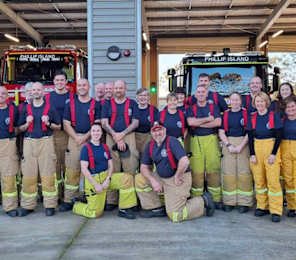LOCAL real estate agents, Glenn Bolam and Adam Leys, of Stockdale and Leggo Inverloch, believe the introduction of a 7.5 per cent levy on short stay accommodation platforms will do little to release properties into the permanent rental market.
And they say the levy amount will almost certainly be passed on to those booking their accommodation through online platforms such as Airbnb and Stayz.
“I think they’ve acknowledged it now that it’s basically just another tax, but the original idea was that it might encourage more holiday homeowners to hand over these homes to the permanent rental market,” said Mr Bolam.
“But most of the people down here have bought a second house for their own use, and for the use of their families. Some of them offer them for holiday rental, mainly to recover the outgoings of rates, insurance etc but they want to keep them available for their own use.”
Mr Leys said there was some indication that a limited number of investors had put their properties on the market, due to rising interest rates, power, and other costs, and with other investment options now available, but in general terms, property was still tightly held within the town.
They were commenting on the decision by the State Government, on Wednesday, September 21 to introduce a “landmark package of measures to boost housing supply and affordability in rural and regional Victoria”, including the 7.5 per cent levy on short-stay platforms, expected to generate $70 million annually.
They did however note that encouragement for the building and construction sector within the package was welcome.
Airbnb has wasted no time in coming out against what is one of the highest such taxes in the world, also accusing the State Government of discriminating against mum and dad holiday home owners.
“Airbnb supports tourism taxes. We’ve worked with many cities around the world to make visitor levies work, remitting over AUD$10-billion in taxes globally – a vital source of funding for local governments that is supporting local communities, critical infrastructure and housing projects,” said Susan Wheeldon is the Country Manager of Airbnb in Australia and New Zealand.
“The Victorian Government has listened, but its proposal differs from ours in two important ways. Firstly, and most critically, the levy will apply only to short-term rental accommodation, creating an uneven playing field that puts everyday Victorians who share their home behind large corporate hotel chains.
“Secondly, they have arrived at a levy of 7.5 percent, which is too high and will slug travellers’ hip pockets when they can least afford it. A contribution of 3 to 5 percent across all accommodation providers will raise more, but cost travellers less,” Mrs Wheeldon said.
Shadow Minister for Tourism, Sam Groth, is predictably critical of the new initiatives, saying the levy could add over $100 to the cost of a weekend away, reducing the amount they’ll have available for meals out and entertainment.
“Every dollar spent on the Andrews Government’s new Holiday and Tourism Tax is one less dollar being spent on local retail, hospitality, events and tourism businesses across Victoria,” Mr Growth said.
“Victorians who work hard to afford a weekend away shouldn’t be the ones to pay for the Andrews Government’s record debt or to fulfil a global company’s social responsibility.”
But the short-stay levy is only one aspect of a comprehensive package of measures designed to attack the state’s housing crisis, with ambitious construction goals and reforms of local government planning arrangements among the initiatives.
The State Government says it represents the biggest shake-up to planning and housing reform in generations.
“Victoria is growing. We’re the fastest growing state in Australia, with our population set to hit 10.3 million by 2051 – and regional Victoria will be home to more than 2.3 million. To ease the housing pressure Victorians are facing, we need to build 2.24 million homes in that time – around 80,000 a year,” according to the statement about the ‘The Decade Ahead 2024-2034’ document which sets a bold target to build 800,000 new homes across the state over the next 10 years, delivered through an ‘Affordability Partnership’ with the housing industry.
That includes a target to build 648,000 new homes in metropolitan Melbourne and 152,000 new homes in regional and rural Victoria.
“But we won’t stop there. As part of our work to build the 2.24 million homes Victoria will need by 2051, we’ll also set a regional target to build 425,600 of those homes across our regions and rural areas.”
Victoria’s Housing Statement focuses on five key areas to tackle the root of the problem, housing supply:
(1.) Good decisions, made faster: reforming Victoria’s planning system, clearing the backlog of planning permits, giving builders, buyers and renovators certainty about how long approvals will take and a clear pathway to resolve issues quickly if those timeframes aren’t met.
(2.) Cheaper housing, closer to where you work: unlocking new spaces to stop urban sprawl, building more homes closer to where people have the transport, roads, hospitals and schools they need and delivering vital, basic community infrastructure.
(3.) Protecting renters’ rights: closing loopholes that drive up the cost of living for renters, giving tenants more certainty over their leases, living standards and finances, and resolving disputes faster to keep them out of VCAT.
(4.) More social housing: rapidly accelerating the rollout of social and affordable homes across Victoria and launching Australia’s biggest urban renewal project across Melbourne’s 44 high-rise social housing towers.
(5.) A long-term housing plan: delivering a long-term plan to guide how our state grows in the decades ahead, and reviewing the Planning and Environment Act 1987 to build a planning system that works with Victorians – not against them.
In recognition of the joint effort needed to ease the housing pressure Victorians face, the State Government has signed the Affordability Partnership alongside the Property Council of Australia, Master Builders Victoria, the Urban Development Institute of Australia, the Housing Industry Association and Super Housing Partnerships.
“The status quo is not an option, and admiring the problem will only make it worse. Unless we take bold and decisive action now, Victorians will be paying the price for generations to come,” said Premier Daniel Andrews.
“Whether you’re buying your first place, upsizing or downsizing as life changes, or renting – the work we’re doing will mean there’ll be a place you can afford, and that you can call home.”
He said there would be a range of initiatives that will benefit people living in rural and regional Victoria.
“By expanding Victoria’s Development Facilitation Program, we’ll boost critical housing supply in regional Victoria.
“We’ll streamline the planning process for significant regional housing developments worth at least $15 million and commit to delivering at least 10 per cent affordable housing, including build-to-rent projects.
“We are making it easier to build a second small home – they give families the space to grow together, provide a critical second income or give kids somewhere to stay when they visit for the weekend. Dwelling garden units won’t require a planning permit if they’re less than 60 square metres.”
Saving for a deposit, he said, is taking longer and getting harder.
“That’s why we’ll release another $500 million from the Victorian Homebuyer Fund, putting home ownership within reach for more regional Victorians. And we’ll unlock and rezone surplus government land to deliver 9,000 homes across 45 sites in Melbourne and regional Victoria.”
The Victorian Planning Authority will continue preparing Precinct Structure Plans (PSPs) for new housing and jobs in regional Victoria – with further work across priority projects in Wonthaggi, Ballarat, Shepparton South East, Corio Norlane, Bannockburn South East, East of Aberline and Ballarat North to continue, to deliver more homes and jobs.
The work being facilitated as part of this Housing Statement will support 16,000 jobs across Victoria, they say.
“This Housing Statement comes addition to our $1 billion Regional Housing Fund – which will deliver more than 1300 homes across regional Victoria in a mix of social and affordable housing. We’re working closely with councils, regional partnerships and local communities to determine the right mix of stock and locations for each region.
Regional worker housing boost
The initiative is also designed to address one of the most pressing problems facing growing regional communities, housing for staff.
“We are also investing $150 million in the Regional Worker Accommodation Fund to provide new housing options for regional communities where key workers are struggling to find affordable places to live. The package will make regional workers’ jobs more secure and make it easier for businesses to find and keep staff,” according to the State Government.
As part of our $5.3 billion Big Housing Build, 25 per cent of new social homes will be delivered in rural and regional Victoria – a $1.25 billion investment in the housing regional Victorians deserve.
“Nothing is more important than finding your own home – this package is delivering real and lasting benefits to rural and regional Victorians by helping more of them live where they want to live,” said Minister for Housing Colin Brooks.
"Finding a place to live is one of the biggest challenges in attracting and keeping workers in the regions – the housing statement is about delivering more homes sooner, creating secure jobs, helping businesses to grow, and taking pressure off renters and first home buyers across rural and regional Victoria,” said Minister for Regional Development and Eastern Victoria MP, Harriet Shing.
For more information, visit: http://www.vic.gov.au/housing-statement
See also a related article at: https://www.sgst.com.au/news/shire-cant-collect-short-stay-charge-government-says










